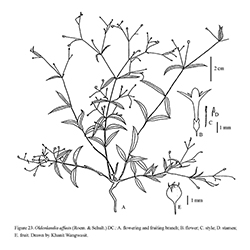e-Flora of Thailand
Volume 15 > Part 1 > Year 2021 > Page 122 > Rubiaceae > Oldenlandia
1. Oldenlandia affinis (Roem. & Schult.) DC.wfo-0000254691
Prodr. 4: 428. 1830; Wight & Arn., Prodr. Fl. Ind. Orient.: 411. 1834.— Hedyotis affinis Roem. & Schult., Syst. Veg. 3: 194. 1818; Bremek., Verh. Kon. Ned. Akad. Wetensch., Afd. Natuurk., Sect. 2, 48(2): 226. 1952; R.J.Wang in K.M.Wong et al., Fl. Singapore 13: 112. 2019. Fig. 23.
Accepted Name : This is currently accepted.
Synonyms & Citations :
Description : Ascending or procumbent herbs; stems 10–50 cm tall, terete in old brancher, quadrangular and 4-ribbed when young, papillose at base. Stipules deltoid, with 1–5 filiform appendages. Leaves narrowly elliptic or linear, 10–30 by 2–6 mm, apex acute, base acute or cuneate, chartaceous, papillose above, on margin and midrib beneath, lateral veins inconspicuous; petiole 0.2–0.5 mm long. Inflorescences terminal and axillary, dichasial cymes, ultimate branching monochasial. Flowers pink or violet, infundibuliform; heterostylous; pedicels filiform, 5–15 mm long. Calyx lobes ovate or deltoid, 0.4–0.6 mm long, apex acute, margin papillose. Corolla tube 2–3 mm long; lobes oblong, 1.5–2 by 0.3–0.5 mm, apex acute, glabrous outside, sparsely pilose inside at mouth of corolla tube. Longistylous flowers: filaments ca 0.3 mm long, glabrous; anthers inserted, ovate, ca 0.8 mm long. Ovary glabrous; style exserted, 4–4.5 mm long, glabrous; stigma 1.2–1.5 mm long. Brevistylous flowers: filaments 0.4–0.5 mm long, glabrous; anthers exserted, ovate, 0.8–1 mm long; style inserted, 1.5–2 mm long, glabrous; stigma 0.8–1.2 mm long. Capsules 1.5–2 by 1.8–2.2 mm, widest at middle of capsule, glabrous, beak protruding not exserted calyx. Seeds 15–30 per locule, triangular-ellipsoid, 0.2–0.3 by ca 0.2 mm, reticulate.
Thailand : PENINSULAR: Ranong (Ngao Falls, Laem Son NP), Phangnga (San Ko Rat, Takuatung), Phuket (Tonsai Falls, Khao Phra Taeo WS, Thalang), Satun (lectotype of Oldenlandia viarum: Kerr 13669 -K, isolectotypes -ABD BK BM, designated by Wang 2019), Songkhla (Ton Nga Chang WS).
Distribution : Tropical and southern Africa, India (type), Myanmar, Malay Peninsula including Singapore.
Ecology : Sea shore, grass field, open place, sandy soil, 0–50 m alt. Flowering: July–April.
Vernacular : Thop thaep tai (ถอบแถบใต้).
Notes: Craib (1931) described Oldenlandia viarum from Peninsular Thailand, while O. affinis, described from India, is found mostly in Africa but more widespread. Oldenlandia affinis is distinctive on account of its pink or violet, infundibuliform flowers. On examination of Thai collections we agree with Wang (2019) to consider O. viarum as conspecific with O. affinis.

